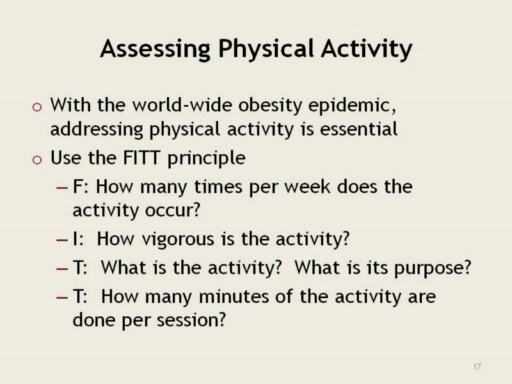| front |1 |2 |3 |4 |5 |6 |7 |8 |9 |10 |11 |12 |13 |14 |15 |16 |17 |18 |19 |20 |21 |22 |23 |24 |25 |26 |27 |28 |29 |30 |31 |32 |33 |34 |review |
 |
Adults should get at least 30 minutes of physical activity 5 times a week.
The FITT Principle Frequency, Intensity, Time, and Type of exercise Frequency 3-5 days/week More frequent exercise is desirable, but focus on establishing a regular exercise habit before recommending levels that may not be sustainable in the long term Intensity Start at a low to moderate intensity and gradually progress over several weeks or months to more vigorous efforts Emphasis should be on increasing duration rather than intensity, with the goal of optimizing caloric expenditure. Time 30 to 60 minutes, using a gradual progression Multiple short bouts produce similar benefits as a single long bout of the same total duration. Type Low-impact activities (e.g., walking, cycling, low-impact aerobics, water exercise) that are convenient, accessible, and perceived as enjoyable by the patient
McInnis KJ, Franklin BA, Rippe JM. Counseling for physical activity in overweight and obese patients. Am Fam Physician. Mar 15;67(6):1249-56, 2003.
Also knowing personal characteristics (age, sex, ethnicity, stage of development, any disabilities), socioeconomic status, and environmental factors are important. Access to safe play areas, family attitudes towards exercise, motivation/support for making physical activity a priority, asking kids how much physical activity parents engage in are all good ways to assess physical activity adequacy |